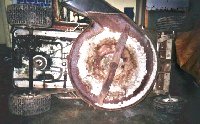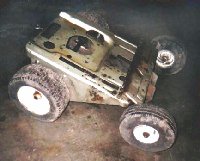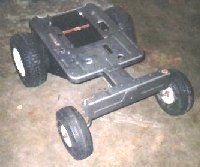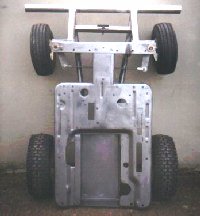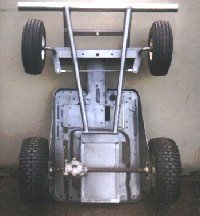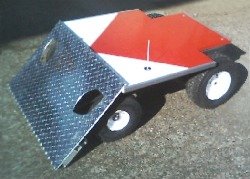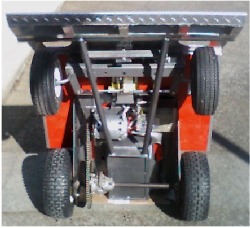
Complicated design is easy. Simple takes work.
Constructing Run Amok
How We Built the Robotica Champion
Privacy Policy I had just finished watching my favorite show on The Learning Channel - 'Junkyard Wars' - when a little 30-second segment came on announcing that applications were being taken for the TLC Robot Challenge, and directing you to the TLC website for more information. I was down the stairs and at my computer within a minute. I sent in an email asking for an application. The info indicated that they were looking for "people with interesting storylines". Heck, I'm interesting and I write a pretty good resume, so I filled out the application and waited. (Continued)
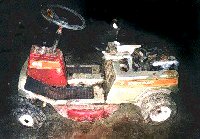
|
I had a notebook full of sketches and random design ideas for robots that I'd been putting together since my first exposure to combat robotics a couple of years earlier -- a wide variety of shapes, drivetrains, weapons, and control systems. But, this competition was going to be different than others that I'd seen. Power and destructive force were going to be important, but so also would be speed and agility. Where would the correct balance be?
A few days passed, and I got a call from one of the producers for a telephone interview. It went well, and I was asked to send some pictures of projects that would show my aptitude for robotics. I sent in some shots of my built-from-a-pile-of-rusted-parts sports race car, a mock-up of an all-terrain robot with a 5-axis arm, and shots of my 1/10th and 1/12th scale remote control road racers. They liked it! A couple days later I got an email telling me that I was "in".
Now came the waiting. The official rules were due out January 2nd. The only things we knew at this point were that the robots had to fit inside a 4 foot cube with no weight limit! My early designs called for a four foot cube of reinforced concrete with the drive train fitted from a used forklift. Very hefty! Then the rules arrived, and a weight limit of 200 lbs. had appeared (it would later be modified to 210 lbs.), along with descriptions of the courses that made a stonking great cube of concrete completely unworkable.
I went looking for a small "quad-bike" style off-road racer. I could strip the engine out, shorten the chassis, and install the electric motor, batteries, and electronics without much trouble. Unfortunately, it was January and all the quad bikes were hibernating. Wasted a week trying to find one for sale without any luck. About this same time, a rules modification (one of many) came along removing the "jump" from the race track. The quad-bike idea was dead.
Well, if we don't need suspension to fly off the jump, how about a go-kart? Lots of pre-made pieces to choose from, and there must be plenty of them lying around, no? Again, shorten an existing chassis, install the electrical bits and we're off. It was still January, however, and the same hibernation that had claimed the quad-bikes had apparently gotten to the go-kart crowd as well. Besides, I found out that very few go-karts have differentials, and I needed one for the 'bot if it was going to be able to make the tight turns needed in the maze.
Time was wasting. Just about at this point, I found an internet site for remote controlled lawn mowers that some guy in Florida had been building. He used a lot of pieces from riding lawn mowers and had put together some interesting machines. They had an aluminum deck, a big R/C servo for steering, and smaller servos for throttle and forward/neutral/reverse shifting. They also had real differentials from riding lawn mowers.
I ran to the phone book and started calling around lawn equipment repair places looking for someone who had a scrap heap of old lawn mower parts for me to pick thru. Fortunately, lawn mowers don't hibernate in Oregon in January. I found Kevin's Farm Service -- a place just outside the city that had a "boneyard" of old lawn equipment out behind a barn. I talked with Kevin a bit and he walked me out into the boneyard where we rapidly found a dead "Murray 7" with a chain driven differential in working order. This was progress!
As I looked at the rusting hulk, I noticed that the entire engine carrier/axle assembly was heavy stamped steel and a convenient size. Hmmmm... And that front steering beam with stub axles looked interesting too. The U-channel main chassis backbone would link the carrier and beam together if I shortened it. The wheels are rusty and a little worse for wear around the rims, but they're pretty straight and fit the axles. Cautiously, I asked Kevin how much he might want for the whole thing. "How about twenty bucks?", he responded.
I am indebted to Kevin, and to Max at Creative Steel in Salem, Oregon for their help in this project. Max is an ace welder and metal fabricator who designed and built the battery box, bumper, and wedge for Run Amok. Look for him to show up with his own robot some day soon.
You can read my journal of the Robotica competition itself here: Robotica Journal
Questions? Read the Run Amok FAQ.
You can reach Team Run Amok by e-mail at: joerger@toast.net
